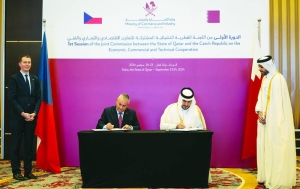Central Asia
Bank of Korea holds its key interest rate steady


The Bank of Korea headquarters in Seoul. The BoK held its key interest rate steady while taking a more dovish tilt, with the governor keeping his options open on whether a policy pivot might come in October or November.
The Bank of Korea (BoK) held its key interest rate steady while taking a more dovish tilt, with the governor keeping his options open on whether a policy pivot might come in October or November.
The central bank kept its seven-day repurchase rate at 3.5% in a unanimous decision yesterday, meeting the expectations of 22 of 23 economists surveyed by Bloomberg. The won and the yield on three-year bonds edged lower after the statement.
In his post-decision press conference, Governor Rhee Chang-yong said four board members were open to cutting rates in the next three months. That’s up from two who voiced that view at the previous meeting. In addition, the statement took a dovish tilt as authorities removed a pledge to keep rates steady “for a sufficient period of time,” implying the bank is closer to cutting interest rates.
“Our three-month horizon includes both October and November,” Rhee said. “It’s hard to tell which direction the board will make its judgment in.”
Economists have long perceived the presence of a dissenter as an indication that a policy change is imminent. The lack of one on Thursday, coupled with the doubling of members open to a near-term cut, complicates the process for gauging the BoK’s rate trajectory.
The ambiguity may prompt a change of heart among some of the overwhelming majority of economists who have been predicting a pivot in October.
In the statement, the BoK said the board will “thoroughly assess the tradeoffs among policy variables such as inflation, growth, and financial stability, and examine the proper timing of rate cuts while maintaining a restrictive monetary policy stance.”
“The BoK affirms our view that they are closer to a rate cut but that it is not a done deal yet,” said Wee Khoon Chong, senior market strategist at Bank of New York Mellon. “Rhee’s remark that his forward guidance doesn’t guarantee a rate cut makes a lot of sense as there is no need to encourage expectations for a deeper rate cut beyond the 25 basis points that’s already priced in over the next six months.”
Inflation has continued to trend lower, adding to confidence for the BoK that its restrictive policy has been paying off, and the conditions for a policy shift are being fulfilled, Rhee said.
But an acceleration in Seoul’s home prices poses a threat to the BoK’s mandate to safeguard financial stability, he said, adding the board is “trying hard to stop the rise” and avoid exacerbating the drag that household debt puts on long-term economic growth.
“It’s a toss-up for an October cut,” Moon Junghiu, economist at KB Kookmin Bank, said. “There’s danger that the BoK may miss the right timing for a cut, but the current economic situation shows that would be unlikely.”
For now, an export rally that’s driving economic growth has persuaded monetary authorities they can retain policy settings they consider restrictive for a little while longer. Export growth accelerated in the first 20 days of August with semiconductors leading the momentum. That gives the central bank room to continue cooling potential threats to financial stability.
“There is no need to rush to a cut when the focus remains on financial stability around real estate and household debt,” said Kim Sung-soo, an analyst at Hanwha Investment & Securities Co. “The economy is holding up well with exports growing, too. So an October cut and then a hold until the end of the year is likely.” The won’s weakness adds to the case for standing pat. Korea’s currency remains among the weakest performers against the dollar this year.
The central bank kept its seven-day repurchase rate at 3.5% in a unanimous decision yesterday, meeting the expectations of 22 of 23 economists surveyed by Bloomberg. The won and the yield on three-year bonds edged lower after the statement.
In his post-decision press conference, Governor Rhee Chang-yong said four board members were open to cutting rates in the next three months. That’s up from two who voiced that view at the previous meeting. In addition, the statement took a dovish tilt as authorities removed a pledge to keep rates steady “for a sufficient period of time,” implying the bank is closer to cutting interest rates.
“Our three-month horizon includes both October and November,” Rhee said. “It’s hard to tell which direction the board will make its judgment in.”
Economists have long perceived the presence of a dissenter as an indication that a policy change is imminent. The lack of one on Thursday, coupled with the doubling of members open to a near-term cut, complicates the process for gauging the BoK’s rate trajectory.
The ambiguity may prompt a change of heart among some of the overwhelming majority of economists who have been predicting a pivot in October.
In the statement, the BoK said the board will “thoroughly assess the tradeoffs among policy variables such as inflation, growth, and financial stability, and examine the proper timing of rate cuts while maintaining a restrictive monetary policy stance.”
“The BoK affirms our view that they are closer to a rate cut but that it is not a done deal yet,” said Wee Khoon Chong, senior market strategist at Bank of New York Mellon. “Rhee’s remark that his forward guidance doesn’t guarantee a rate cut makes a lot of sense as there is no need to encourage expectations for a deeper rate cut beyond the 25 basis points that’s already priced in over the next six months.”
Inflation has continued to trend lower, adding to confidence for the BoK that its restrictive policy has been paying off, and the conditions for a policy shift are being fulfilled, Rhee said.
But an acceleration in Seoul’s home prices poses a threat to the BoK’s mandate to safeguard financial stability, he said, adding the board is “trying hard to stop the rise” and avoid exacerbating the drag that household debt puts on long-term economic growth.
“It’s a toss-up for an October cut,” Moon Junghiu, economist at KB Kookmin Bank, said. “There’s danger that the BoK may miss the right timing for a cut, but the current economic situation shows that would be unlikely.”
For now, an export rally that’s driving economic growth has persuaded monetary authorities they can retain policy settings they consider restrictive for a little while longer. Export growth accelerated in the first 20 days of August with semiconductors leading the momentum. That gives the central bank room to continue cooling potential threats to financial stability.
“There is no need to rush to a cut when the focus remains on financial stability around real estate and household debt,” said Kim Sung-soo, an analyst at Hanwha Investment & Securities Co. “The economy is holding up well with exports growing, too. So an October cut and then a hold until the end of the year is likely.” The won’s weakness adds to the case for standing pat. Korea’s currency remains among the weakest performers against the dollar this year.







